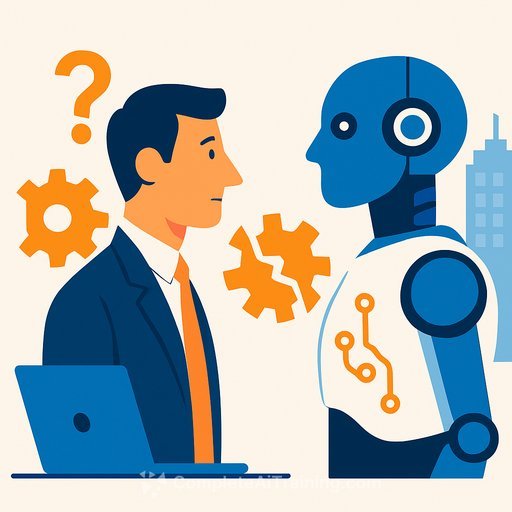Reality Check: The Barriers That Limit AI's Impact on Jobs
Headlines say mass layoffs are around the corner. Some leaders even predict double-digit unemployment and the loss of half of entry-level white-collar roles within a few years. Fear spreads fast when it sounds inevitable.
The data paints a more nuanced picture. Automation is advancing, but two kinds of barriers - technical and nontechnical - are slowing broad job loss. For HR, this is the space where smart workforce strategy wins.
The two barriers HR must assess
Technical barriers: Can the tool do the task at the needed quality, speed, and cost? In many jobs, yes - at least for a chunk of the workload. Our analysis indicates that at least 50% of tasks are automated in 15.1% of U.S. wage and salary employment, about 23.2 million jobs.
Nontechnical barriers: Even if the tech works, will the job be replaced? Often no. Legal, regulatory, trust, safety, brand, and client preference issues slow or block displacement. Think aviation: planes fly with heavy automation, yet pilots remain essential - by law and by passenger expectation.
What the numbers say right now
Looking only at technical capability, a bit over 15% of workers face high displacement risk because half of their tasks are already automated. The share varies by occupation: roughly 32% in computer and mathematical jobs and about 7.3% in education and library roles.
Add nontechnical barriers and the risk drops sharply. Only about 6% of wage and salary employment - roughly 9.2 million jobs - is both at least half automated and faces no nontechnical barriers. Nearly 13% of computer and mathematical roles meet both conditions, while six groups - including education and health care - fall below 5%.
Why nontechnical barriers matter
Client preference is the standout barrier. Many customers still want a human for advice, accountability, or sensitive decisions. Brand risk, compliance, and safety concerns add weight, especially in health, finance, government, and customer-facing work.
These barriers can change. As people get comfortable with AI interfaces, preference-based resistance may fade. HR should plan for both today's guardrails and tomorrow's drift.
HR playbook: Reduce risk, increase value
- Task mapping: Break jobs into tasks. Estimate the percent already automated or automatable. Flag roles at or above the 50% threshold.
- Barrier audit: List legal, regulatory, client preference, safety, brand, and trust constraints by role. Rate each barrier as strong, moderate, or weak.
- Prioritize by "two-factor risk": High automation share and weak barriers move to the front of the queue for redesign.
- Job redesign before headcount cuts: Eliminate low-value tasks, concentrate people on judgment, relationships, and exception handling, and consolidate residual tasks across teams.
- Upskill and redeploy: Build AI fluency, QA, data literacy, and workflow design skills. Shift capacity to roles that increase revenue, quality, or customer retention.
- Guardrails: Set policies for accuracy checks, data privacy, bias review, and human-in-the-loop thresholds. Document approvals and audit trails.
- Pilots with metrics: Test in one function, measure cycle time, error rate, satisfaction, and cost per task, then scale.
- Talent planning: Update job architectures, career paths, and compensation for AI-augmented roles (e.g., automation analyst, model overseer, prompt specialist, QA lead).
- Change management: Communicate early. Tie AI use to role security through reskilling commitments and clear standards for quality and accountability.
Signals to monitor each quarter
- Client sentiment: Are customers opting into AI channels without incentives? Track CSAT by channel and deflection rates.
- Regulation and contracts: New rules or client clauses that expand or restrict automation.
- Model reliability: Error profiles, hallucination rates, and edge-case failures in your domain.
- Labor market data: Hiring difficulty and wage pressure for human roles that complement AI (e.g., QA, compliance, domain experts).
What this means for workforce decisions
AI will displace some roles soon, especially where 50%+ of tasks are automated and nontechnical barriers are weak. But for most jobs, effects will be uneven and phased, not sudden. That creates room for HR to shape outcomes with skill pathways, job redesign, and policy.
The winners will treat automation as a task-level redesign problem, not a blunt headcount lever. Map tasks, assess barriers, pilot, measure, then scale.
Helpful resources
- U.S. Bureau of Labor Statistics: Occupational Outlook Handbook - job functions and skills to inform task mapping.
- OECD: Automation and employment policy responses - cross-country perspective on risk and guardrails.
Build skills while you redesign work
As you re-scope roles and set guardrails, upskill HR and business teams to use AI responsibly and productively. Start with focused learning tied to core workflows.
- Courses by job role - practical tracks aligned to daily work.
- Popular AI certifications - signal skills for new AI-augmented roles.
Bottom line for HR
Measure tasks, respect barriers, and move in controlled increments. The risk is real for a minority of roles, but the bigger opportunity is redeploying talent toward higher-value work - with trust, compliance, and customer preference intact.
Your membership also unlocks:






